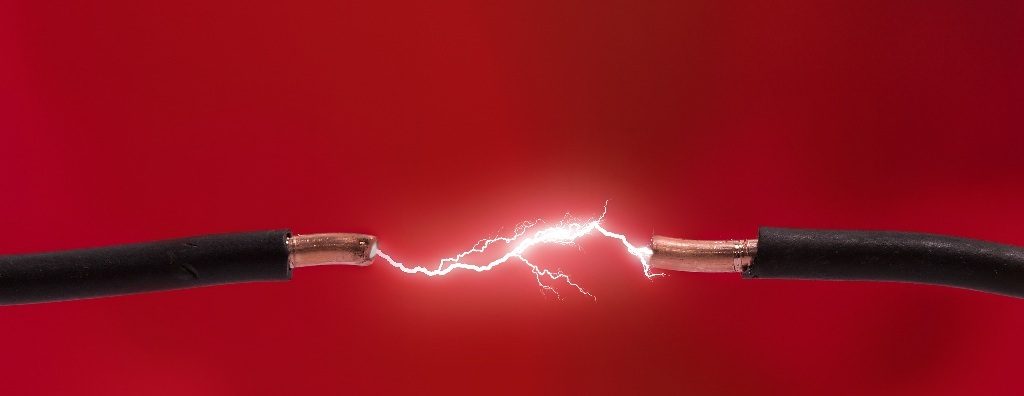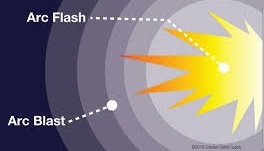What is Arc Flash Definition?
Arc flash definition according to NFPA 70E is the sudden release of unexpected heat and light energy produced by electricity passing through the air like a lightning. Arc flash is also a phenomenon that is usually caused by accidental connection between live conductors, or between live conductors and the ground. Temperature at the arc point can reach or even more than 35000 Fahrenheit. It is four times the surface temperature of the sun. The air and gas around the arc rapidly heats up and the conductor becomes steam which causes waves called arc blasts. Arc blast is an advanced phenomenon of arc flash events. This article will discuss what the definition, hazard category and risk level of arc flash and arc blast is according to or based on NFPA 70E. The NFPA 70E is most popular standard as reference to conduct arc flash hazard or risk assessment.
———————————————
Metric of Arc Flash
To determine the potential effects of arc flash, we need to understand a few basic terms. Arc flash produces high heat at the point of occurrence of the arc. Heat energy is measured in units such as BTU, joules, or calories.
Calorie is the amount of heat energy needed to raise the temperature of one gram of water by one degree Celsius.
Energy is equivalent to power multiplication with time, and power (watts) is equal to volts x Amperes. We can see that calories are directly related to current (amperes), voltage (volts), and time. The greater the current, voltage and time, the greater the calorie produced.
To determine the magnitude of the arc flash and its associated hazards, some basic definitions were made. The amount of heat energy released immediately by an arc flash is called incident energy or incident energy. Incident energy is usually expressed in units of calories per cm2 (cal/cm2) and is defined as heat energy that passes through every 1 cm2. However, some calculation methods state the incident energy in units of Joules/cm2. The unit can be converted into calorie/cm2 units by sharing with a factor of 4.1868.
If we place an instrument that measures incident energy at various distances from a controlled arc flash. We can learn that the magnitude of incident energy varies with the distance from the point at which the arc occurred. The magnitude of the incident energy decreases proportional to the square of the distance in feet. Like walking into a burning room, the closer we get, the greater the heat energy is felt. Tests show that the incident energy of 1.2 cal/cm2 will cause level 2 fires on exposed skin.
———————————————
 Arc Flash Hazards
Arc Flash Hazards
Personnel who are directly exposed to an arc flash and arc blast may experience level 3 fires, possibly blindness, shock, or hearing loss. Even relatively small arcs can cause serious injuries. Secondary effects of arc flash include toxic gas, flying dust, and the potential for damage to electrical devices, enclosures and raceways. High arc temperatures, metal materials that melt and evaporate rapidly will trigger any flammable materials.
Every electrical conductor connected accidentally to another conductor or by ground will produce an arc flash. Frost current will continue to flow until the over-current protection devices (OCPD) open the circuit or until there is something else that makes the current stop flowing. The magnitude of the arc current varies with a maximum of a bolted fault current or a bolted short-circuit current.
To understand the potential effects of the arc flash hazard category, we must first determine the working distance from being able to touch the voltage on the equipment or electrical system. Most measurements or calculations are performed at a working distance of 18 inches or 45cm. This distance is used because it is an approximate distance at which the face or upper body of the worker can be safe from arc flash if it occurs. Some parts of the worker’s body may be less than 18 inches apart, but in other jobs the work might be done more than 18 inches apart. Working distance is used to determine the level of arc flash risks and the types of personal protective equipment (PPE) to protect yourself from danger.
———————————————
Arc Flash Risks Level
NFPA 70E, Electric Work Safety Standards in the workplace, categorizes arc flash levels into five Hazard Risk Categories (HRC 0 to 4).
Based on the amount of energy released at a certain working distance on the occurrence of arc flash:
 Arc flash studies show that many events in industries where arc-flash produces energy of 8 cal/cm2 (HRC 2) or less. But, other accidents can produce 100 cal/cm2 or more (exceeding all HRC). It is important to remember that only 1.2 cal/cm2 (HRC 0) is needed to cause second-degree burns to unprotected skin.
Arc flash studies show that many events in industries where arc-flash produces energy of 8 cal/cm2 (HRC 2) or less. But, other accidents can produce 100 cal/cm2 or more (exceeding all HRC). It is important to remember that only 1.2 cal/cm2 (HRC 0) is needed to cause second-degree burns to unprotected skin.
Determinants of Arc Flash Severity
Several groups and organizations have developed formulas to determine the energy available at various working distances from the arc flash. In all cases, the severity of the arc flash depends on one or more of the following criteria:
- Short circuit current
- System voltage
- Gaps
- Distance from bow
- Opening time of over-current protective devices (OCPD)
When the arc flash is severe enough to occur, the over-current protection device (fuse or circuit breaker) upstream from the interference must cut off the current or the power supply. The magnitude of the incident energy that can be exposed to workers during the arc-flash is directly proportional to the total disconnection time (I²t) of the over-current protection device. The greater the current setting and the opening time of a breaker, the greater the incident energy will be generated. Regarding arc flash, the only variable that can be controlled directly is the time needed for over-current protection devices to extinguish the arc. A practical way to reduce arc-flash is to use an OCPD where the protection device will limit the arc duration.
———————————————
Arc Blast Effect
Definition of arc blast is the aftereffect of arc flash. Arc blast is gas and hot air that can cause an explosion equivalent to TNT due to arc flash. The gases released from the explosion also carry products from the arc including molten metal droplets similar to buckshot. High temperatures will vaporize copper expands at a speed of 67,000 times its mass when changing from solid to vapor. Even large objects such as electric panel doors can be ejected a few feet at very high speeds. In some cases, the bus bar comes out from inside the electrical panel which breaks down the panel wall. Explosion pressure can exceed 2,000 pounds/ft2, dropping workers from stairs or even breaking workers’ lungs. This event happened so fast with speeds exceeding 700 miles/hour that it was not possible for a worker to move away.
———————————————
Related Articles
- Arc Flash Study & Assessment
- Arc Flash Causes Analysis
- Arc Flash Calculation Methods
- Arc Flash Boundary and Requirements of Personal Protective Equipment (PPE)
- Electric Shock Protection Study
- Short Circuit Study and Analysis
- Protection Coordination Study & Analysis
References:
- NFPA 70E – Standard for Electrical Safety in the Workplace
- IEEE 1584 – IEEE Guide for Performing Arc-Flash Hazard Calculations
- Littelfuse article about Arc Flash Hazard
- What is Arc Flash? What is Arc Blast?
———————————————




